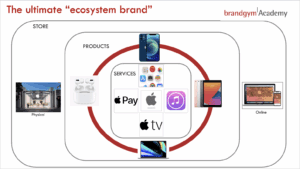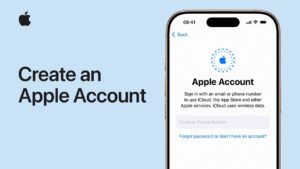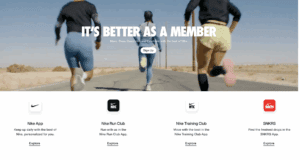Apple recently reported record quarterly revenue for its services business of $27billion, up 13%. Services like Apply Pay, iCloud and Apple TV+ now account for almost 30% of the brand’s revenues (1). This got me thinking about how Apple is an amazing example of an “ecosystem brand”, defined by WARC as:
“An interconnected set of products, services and experiences to meet a wide range of customer needs in a cohesive and integrated manner.”
Ecosystem brands like Apple don’t just sell products, they sell an interconnected way of life. I first posted on ecosystem brands way back in 2011 here. And since then they have grown in importance, creating seamless experiences that “connect the dots” in our increasingly complex lives. Take my experience of creating this blog. I’m writing the post on an iPhone at the airport, having used Apple Wallet to show my boarding pass. I used Apply Pay for the Uber I ordered via an app downloaded from Apple App Store.
So, how do you go about creating and growing an effective ecosystem brand? Here are five key success factors, drawing on Apple and other brands.

1. Build from a strong core
The most powerful ecosystems are built around a strong core product or service that earns trust and anchors the entire brand. For Apple, this core product was once the Mac computer but is now the iPhone. This personal device is the key portal through which most people access the Apple ecosystem. It is the “source of authority” that defines the brand’s design aesthetic and user experience. It is also the key “Source of profit”, with its $200billion of annual sales accounting for half of all Apple’s revenues (1). Amazon built from a strong core in books before expanding into multiple product categories and then into services with Amazon Prime.
2. Create a key to unlock ecosystem access
At the heart of Apple’s ecosystem is something that may not be top of mind when you think about the brand: the Apple Account (formerly Apple ID). This email and password combination is the key used to access the entire ecosystem of interconnected services. It’s hard to pin down an exact quantity of Apple Accounts in use (2). But estimates put the number well over a billion, given that there are over 2 billion Apple devices in the world. If Apple adds a new service, you can use your Apple Account to easily and quickly access it.
Apple Pay is another important enabler of Apple’s ecosystem brand. An estimated 785 million people have activated Apple Pay on their device (3), allowing payment for Apple services with one touch of your fingerprint or a glance at Face ID.
Amazon Prime is another example of an ecosystem key. This gives you the benefit of fast free shipping but also now access to streaming of movies and music.

3. Design a distinctive Brand World
Winning ecosystem brands go beyond product and functionality. They design a distinctive brand world, with one look, one voice and one feeling that flows across every touchpoint. Apple’s minimalist aesthetic and intuitive interface are consistency cues that reinforce the brand with every swipe and scroll.
Nike is another example of a brand designing a distinctive brand world. Nike leverages its distinctive brand assets on products but also in the me
Nike is another brand that does a good job of creating and leveraging distinctive brand assets across its ecosystem. This can be seen in the brand’s products and stores, but also in its membership scheme (see below). Nike Membership gives access to Nike apps, exclusive products, Member-only experiences plus free delivery and receiptless returns.
4. Deliver a seamless set of services
What holds ecosystems together isn’t just the breadth of offerings, it’s the glue between them. This means removing friction at every step to create a seamless service experience. Apple is for me the gold standard of seamless navigation, allowing you to easily move between services. The single Apple ID discussed earlier is a key enabler. But in addition, you get the feeling that it is one unified company behind all the products and services.
Contrast this with the living hell that is Microsoft’s ecosystem. It seems to constantly require me to re-log in using different user names and passwords when switching from, for example, Microsoft Teams and Microsoft 365. When the inevitable error occurs when attempting move from service to service, you are greeted with a stream of technical jargon.
5. Explore physical brand worlds
Many successful ecosystem brands create physical worlds that bring to life the brand experience. Apple again led the way here with Apple Stores, the perfect place to discover, try and buy the ever increasing range of products and accessories. Importantly, the stores are not just a brand showcase but also a significant profit driver. Sales per square foot of $6,000 are 17 times that of the average retailer and twice that of the second best performing store, Tiffany & Co (4).
In conclusion, the key to building a successful ecosystem brand is to deliver a distinctive, connected experience that delivers multiple products or services through a single, seamless journey. I expect Apple to continue to benefit from being the ultimate

